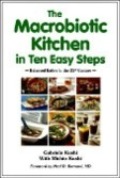Revamp your eating pattern in three easy steps.
For cooking tips. View Gabriele's Online Cooking Class Clips
If you want a consistent natural food lifestyle, join the Long-Distance Wellness Program.
WE ALL KNOW that the food we eat affects our health. This has been proven to us by scientific researchers for decades, and our own experience tells us so. Most of us are not trained as holistic nutritionists. Our knowledge of eating is influenced by the current trend of taking megadose supplements in place of eating balanced meals, and by food advertising that promotes snack foods, fast foods, and soft drinks instead of the basics of a healthful diet. In addition, you may be confused by contradictory diets, which often do not bring us the expected results.
My approach to food is to get away from the concept of diet and, instead, bring nourishment, abundance, and awareness into your life. This path holds unI'versal truths because we all want to be healthy and happy, and feel full of vitality and energy. My suggestion is to include yoga and meditation practices while you are cooking. A little adjustment here and there goes a long way. When you are preparing your meal, or even when you are shopping, it is important to breathe deeply and to hold yourself straight. To be aware and adjust your posture helps you to take conscious control over your life.
Lets take a closer look at our daily eating and drinking habits that are formed at an early age and develop over time. This habit forming takes place at restaurants, in the parks, in our cars, as well as in our kitchens. So, how are we going to start on this journey of self-improvement and how are we going to make it an integral part of our food habits?
Step 1) Keep a journal
Write down everything you eat and drink, every day, for one week. This self-assessment is the first and most important step to being aware of what your habits are and how you nourish your body. It should be done diligently. don't skip this step. Get a journal that you can carry around with you, be honest and don't judge yourselves, just take notes and document what you are doing. This also helps you to find out where and on what you spend your food money.
Keep record on what, when, and how much you eat and drink.
Be specific. Is it a complete meal with a variety of foods, or is it just a snack?
How long does it take you to eat your meal, and how many times do you chew each bite? Do you drink during your meal? Do you savor your meals, or simply eat them?
Learn to estimate the size of the portions you are eating, in standard household measurements, such as cups or ounces.
Write down how you feel after your meal or drink, and how you feel hours later, including both your emotional and physical feelings.
Write down the consistency and frequency of your elimination processes, which is an important part of your self-assessment. (Bowel: movement, consistency, color, frequency; urination: color, frequency; sweating: frequency)
Notice how you prepare your meals. Watch your body language.
Step 2) Examination
After one week, examine your food journal. You will have a pretty good idea about your eating habits. You might notice that you eat a lot of sugar-filled foods, or that your meat intake is on the rise, or that you all too often just grab a bite to eat. You might notice that you are trying to do your chores while hunching over the stove, stirring with tense shoulders, not breathing, and holding the phone with your head. By the time the meal is ready are you sometimes a nervous wreck and just want to veg out on the couch in front of the TV and eat.
Step 3) Making Changes
Another important yoga practice, besides being aware of your posture and your breathing, is to eat regularly. This means eat three small complete meals everyday that include a variety of foods, and one or two smaller nutritious snacks between meals.
If you aspire to eat more wholesome foods I suggest gradually incorporating the following steps:
Start with a clean space for your yoga practice. Get a large box and throw everything in there that is not on your whole and natural food list. Clean out your refrigerator and cupboards.
Start reading labels, look for hidden sugars and fats, and buy organic products whenever possible.
Increase protein-rich foods from sources such as beans, seeds, nuts, and whole grains, and decrease your intake of cholesterol-rich animal fats and animal foods.
Substitute less-refined sweeteners like rice syrup, maple syrup, or sweet vegetables for consumption of refined white sugar or corn syrup.
Increase whole grain products, which should be the staple of your diet, and decrease products made from refined white flour like French bread, bagels, crackers, cakes, or white rice.
Increase consumption of regional and seasonal fruits and vegetables.
Substitute spring water, green tea, and herbal tea for soft drinks, soda, alcohol, and coffee.
Through the awareness in your kitchen and these gradual adjustments to wholesome foods, you will bring abundance and healthy nourishment into your life. Keep writing in your food journal and frequently refer to your early entries to monitor your self-improvement.
Gabriele Kushi Invites You To A Lifetime Of Deep-Seated Knowledge!
Join her Long-Distance Wellness Programs
“If you want a consistent natural food lifestyle, then this program is for you!”
Copyright @ 2024 Gabriele Kushi and http://www.kushiskitchen.com provides educational services only, and does not provide medical nor nutritional advice, diagnosis nor treatments.
Through my affiliate links and book links I might earn a small compensation.
By using this website and my services you agree with the Disclaimer and Privacy Policy.
Click to add text...



